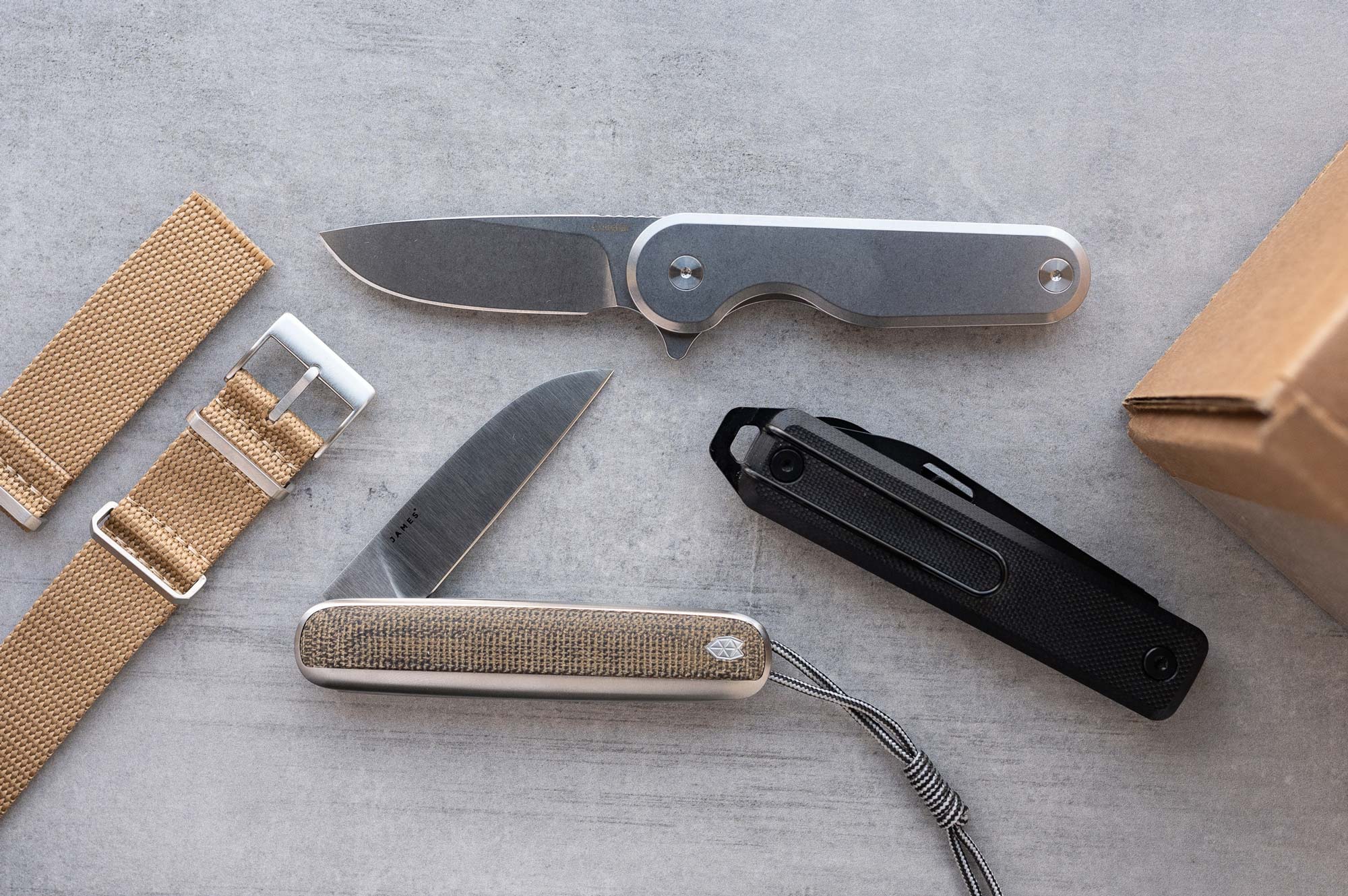Knives can be a bit intimidating, but we consider them tools just like the rest of your EDC gear. Whether you’re opening a package or slicing up an apple, having the right tool for the job makes all the difference in the world. Carrying around a full set of scissors never really makes sense, and a well-designed pocket knife can achieve much of the same functionality without the bulk and awkwardness of walking around with some kitchen shears.

Before we dig in, one of the most important things about carrying a knife is to check your local laws and make sure you’re in compliance. If you happen to be in an area with stricter laws, even keeping a quality pocket knife at home or in your desk will come in handy more often than you think. Nine times out of ten, we’re using our pocket knives to open a new watch box, help prep some lunch, or any variety of slicing tasks. Let’s dig in and take a closer look at the world of everyday carry knives, along with some excellent options that we’ve curated here at the Windup Watch Shop.
Reasons to Carry a Pocket Knife
There is a myriad of reasons to carry a knife, and here are a few:
Opening packages: Having the right tool for the job is safer for you and whatever’s in the package at hand. With a small knife, you can precisely cut tape and boxes. A sharper knife is also a safer knife, so you’re never putting too much pressure on the blade, which could cause the knife to slip and result in injury.
Food prep: If you have a dedicated knife (or just happen to keep yours pretty clean), a pocket knife can come in super handy when prepping food. If you’re away from the kitchen, use yours to open food packaging, slice an apple, or cut up some meat.


Recreation: Out of office? A pocket knife can be an essential tool on a hike or camping trip. You can use the knife to shave off bark for a fire starter, trim some fishing line when you hit the river, and even prep some food around the fire. You’d be hard-pressed to find a hiking pack without some form of pocket knife as an essential piece of kit.
If you’re just thinking about picking a knife up for the first time, there are a ton of different styles that include different blade shapes, locking mechanisms, overall designs, and handle materials. It can be overwhelming to make a choice, so here’s a breakdown on some of the basics that are sure to help:
Blade Shapes
Drop Point: One of the most common and versatile blade shapes. A curved top edge that “drops” down below the spine (top of the blade) makes for a strong and sturdy shape that’s great for pretty much everything. It also centers the point of the blade, making for easy piercing. The curved cutting edge is also ideal for both slicing and piercing thanks to its shape.


Clip Point: Another common shape, the clip point looks as though the first third of the blade has been “clipped” off. The resulting shape has a narrower tip, which is optimal for piercing tasks. This style of knife has been used for thousands of years, and continues to be popular today. Between the piercing point and large belly area for slicing, the clip point is a versatile (and cool looking) blade shape.
Sheepsfoot: Sheepsfoot blades have a straight cutting edge on the bottom and a spine that dramatically curves down to meet the point. This blade design was originally meant to keep the point out of the way, when slicing without piercing is of the utmost importance.


Wharncliffe: Similar to the sheepsfoot, the Wharncliffe has a straight cutting edge, but a curved spine. They also feature a narrower and sharper tip that’s great for detailed work.
Now that you have a better idea of what the different blade shapes do, keeping said blade locked in place is next. Keep in mind that some different knife laws around the globe have different regulations on locking mechanisms as well. Typically, it’s either locking or non-locking, and they don't get too specific. Let’s take a look at a few common locking mechanisms:
Locking Mechanisms


Slipjoint: Slipjoint locking mechanisms are not technically a lock, since they can be pushed back in with some force. If you’ve ever used a classic Swiss Army knife, then you’ve used a slipjoint. Typically requiring two hands to open and close, a spring-loaded bar of steel keeps the blade on a slipjoint in place when open, but requires a bit of force to close.


Framelock: This integrated style of lock is built right into the handle of the blade. Typically seen on knives with steel or titanium handles, the frame lock design is cut out of the handle, with the lock portion bent inwards. When the knife is opened, the lock’s pressure on the blade is relived, and it will click into place behind the blade. These are very strong locking mechanisms, since a thick portion of the handle of the knife is holding the blade open. To close a frame lock, simply push the lock section back away from the center of the knife, and slide the blade back down.


Slide Lock / AXIS Lock: This unique mechanism features a spring loaded stud that runs through the knife. To unlock the knife, simply slide the lock towards the back of the knife and open the blade. Once open, the spring-loaded stud locks into a channel in the back of the blade, keeping securely in place. It’s an easy to use mechanism that can be operated with a single hand and a flick of the wrist.
Liner Lock: Liner locks are similar to the frame lock, just on a smaller scale. Instead of a piece of the handle bending inwards when the knife is open, a small portion of the liner (typically steel or titanium that the handles are mounted to) locks into place. This style of lock allows for both handles to be made of the same material, whether it be G10 resin, micarta, metal, or wood.

Hopefully by now you have a better idea of why to carry a knife, what the different blade shapes accomplish, and how they lock into place. Keep an eye out for part two of our primer on pocket knives for a look at carry methods, handle materials, and the differences between blade steels.
For more Everyday Carry check out our collection of EDC goods here

























